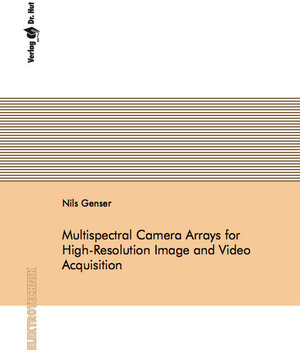
×
![Buchcover ISBN 9783843950978]()
Multispectral Camera Arrays for High-Resolution Image and Video Acquisition
von Nils GenserNumerous applications have emerged in recent years that require multispectral imaging solutions. However, the acquisition of multispectral data is challenging up to the present even if there is a great demand for easy to use imaging devices. State-of-the-art setups are in general expensive, inflexible, and achieve a low spatial, spectral, or temporal resolution. In addition, they are often tied to specific professional applications and, therefore, are not available for the consumer market.
To address these shortcomings, multispectral camera arrays that employ a separate image sensor for each acquired spectral component are examined in this dissertation. Thus, the spatial and temporal resolution is only limited by the most recently available image sensors on the market while the spectral resolution can be controlled by the number of utilized cameras. Accordingly, this thesis aims at introducing novel algorithmic solutions for obtaining consistent multispectral videos in an automated manner.
In order to demonstrate the superior performance, the proposed concepts are examined by means of three self-manufactured multispectral camera arrays. Besides an outstanding image quality, the proposed multispectral camera arrays provide further advantages like the ability to achieve a high spatial, spectral, and temporal resolution at the same time. Moreover, the proposed multispectral camera arrays can be set up using off-the-shelf hardware components. Thus, a cost-effective and handy design is possible which allows the employment in compact devices. In addition, the proposed registration algorithms allow deriving accurate depth information which can be used for 3D imaging applications. Finally, the optical filters and therefore, the spectral properties can easily be adapted to the actual use case.
To address these shortcomings, multispectral camera arrays that employ a separate image sensor for each acquired spectral component are examined in this dissertation. Thus, the spatial and temporal resolution is only limited by the most recently available image sensors on the market while the spectral resolution can be controlled by the number of utilized cameras. Accordingly, this thesis aims at introducing novel algorithmic solutions for obtaining consistent multispectral videos in an automated manner.
In order to demonstrate the superior performance, the proposed concepts are examined by means of three self-manufactured multispectral camera arrays. Besides an outstanding image quality, the proposed multispectral camera arrays provide further advantages like the ability to achieve a high spatial, spectral, and temporal resolution at the same time. Moreover, the proposed multispectral camera arrays can be set up using off-the-shelf hardware components. Thus, a cost-effective and handy design is possible which allows the employment in compact devices. In addition, the proposed registration algorithms allow deriving accurate depth information which can be used for 3D imaging applications. Finally, the optical filters and therefore, the spectral properties can easily be adapted to the actual use case.


